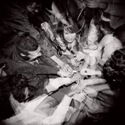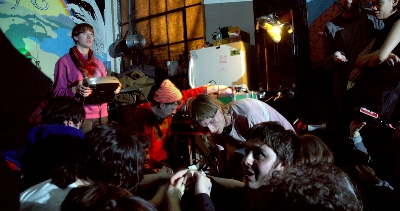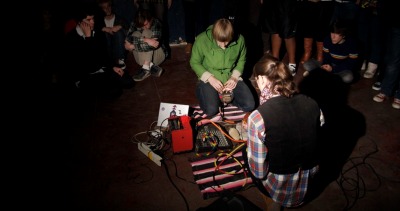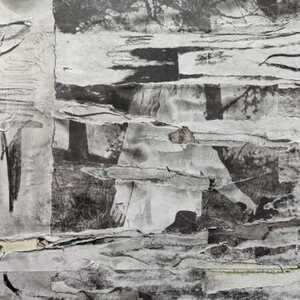
Lucky Dragons
Luke Fischbeck
Penny Duff
“Straightforward experimental” is an oxymoron, but uber-experimentalist Luke Fischbeck describes some of his previous musical projects this way. Don’t get it twisted, I’m not calling Luke a moron – far from it. You understand where he’s coming from once you hear his Lucky Dragons. Heavy on the arts and crafts, the project takes an exuberant approach to often sterile musical terrain, bringing esoteric sonic concepts back to the elementary with simple instruments like recorders and, um… rocks. If you imagine one of Aphex Twin’s self-made music logarithms covering Animal Collective’s Sung Tongs, you wouldn’t be far off the Dragons’ tail. Their live shows are known for their performance art dimension, with the audience often called on to literally interact with the music – more on that later. This unique blend has endeared them to scenesters, seven-year-olds, and serious art buffs alike, playing gigs at New York’s prestigious Whitney Museum of Art where they’re likely to draw as diverse a crowd as you can get. With their Dream Island Laughing Language album released this July, we brought in media studies expert and sound manipulator Penny Duff to talk about the new album, discover how Lucky Dragons “Make a Baby,” and hear Luke’s take on the future of “punk.” What follows, naturally, are the best bits of their conversation, minus the irrelevant stuff about cat sitting and picnic recipes. – S D Green for Ink 19

What are you getting into today?
I’m supposed to go get some fabric with a friend. We’re doing, like, a… I don’t know. We’re making some stuff for an art show, but I stayed up too late last night making music stuff. I do this thing called Sumi Ink Club. It’s like a collaborative drawing thing. We open the space up and have people come in and make the drawings while they’re at the show.
What music were you working on last night?
I was supposed to finish my side of a split 7” a week ago with this band, Ecstatic Sunshine, from Baltimore. We recorded all the stuff for it, and it’s just been editing it. We’re playing kalimbas. It’s a couple of hours of playing these really repetitive patterns. It sounds so good, but the edited version sounds a lot like minimal techno or something – it’s really funny. It somehow acquired a totally different identity.
Can you tell me a bit about the new album, Dream Island Laughing Language?
This record is different than other records in that it’s just me and Sarah [co-conspirator in Lucky Dragons] that made all of the songs but one. Almost all of the sounds are made in our house and are really simple sounds. There are not as many densely layered, edited things as on the old records. It’s very stripped down. There are a couple of songs that are just made with rubber bands and singing, which is a really funny and simple sound.
Any reason in particular that you’re feeling so drawn to this idea of simplicity lately?
It might be a combination of a couple of different things. Maybe I can phrase it in terms of singing or lyrics. I think I’ve always struggled with what is important to say when you’re writing lyrics. Like, what do you really want to tell people? And, we actually had a lot of lyrics written for this record, and we’re singing a lot of stuff. And we kept stripping it down until it was exactly the things that we wanted to say. It came about having not been very planned out beforehand. So many passes through and stripping things away… in the end it was only saying like two or three things! I think that was the best thing for us: If we weren’t going to start with a clear, literal message, at least to have not too much of a sense of it being too didactic or too many different things trying to be said at once, but to have it be simple and vague enough that people can really interpret what they wanted from a few things. I think it’s also an interest in minimalism and just putting something there and having it be much more of a place where people can come to it and attach their own meaning to things. It can support meaning rather than try to tell people what to think.
Can you tell me a bit about your songwriting process?
Generally, the process is about trying to reveal something that will tell us more about what we were doing. As far as the recordings go, we do a lot of little sketches of things and then try to pick out things from that. There’s a long distilling process of trying to get things out of something else. Putting together performance usually starts with an idea of more of a political thing that we want to do. Like, “we want everybody in the audience to be paying attention to each other and not paying attention to something external from the audience,” you know? It’s difficult for me to say if there is one sort of ethics that overrides all this stuff because I think sometimes they’re in total opposition to each other.
Is there anything that stands out in your mind that surprised you the most in terms of the end result?
Definitely. The most fertile, rewarding thing that we do is the touching stuff. It’s called “Make a Baby”; everybody can play the synthesizer together by touching each other. That’s the best because it’s like a social experiment. Just being able to see how people use that and people interacting in ways that we couldn’t anticipate, tells us a lot about, I think, what it means to go and be part of a musical experience as a group. And, that’s ultimately what we’re interested in doing as a band is experiencing music as a community, figuring out where we stand in relation to that and each other.
Can you explain how “Make a Baby” first came about? Where did the idea of “touching music” come from?
We were doing a lot of dance performance stuff and it was sort of an extension of that. It was like a game or a toy that we were playing with where we would take a feedback signal and interrupt it and complete the circuit with our skin. And it was a really nice thing to do for two people because it’s like a circuit that’s interrupted. Then we came up with the idea of using it in a show and the idea was that we’d want everybody to be involved in it. Just ‘cause, you know, when you’re playing a show and you’re playing dance music, you want everybody to dance. So, if you’re playing a “touch” show, then you want everybody to touch. So, we had to figure out how to make that work. It required doing some raiding of software to interpret all the touching and respond to it.

Especially with “Make a Baby,” but also with your other work, you seem to be straddling the distinction between art and music. Where do you see yourself situated in relation to the music and art worlds?
It’s really how to do both equally. The museum thing was huge because I had a realization that it’s not really necessary to go through a gallery system if you want to do art, because you can just do museums. Which I think is pretty amazing because the gallery system is very closed, or it can be. It’s a bunch of crazy people making things for a bunch of people that want to support it, but not participate in it necessarily.
The way music is made and distributed and appreciated has been changing A LOT in the last… just like two years. It’s sort of shaking up a lot and I got this feeling that music should be free. It’s going to be free very soon or it’s already free. You don’t need Capitol [Records] or whatever. You don’t need a company to make the music move around the world, you know?
Growing up, I had really aligned myself more with the sort of do-it-yourself and punk way of distributing things, which was a response against an industry model. What does it mean to be “punk” when the music is free? There are still a lot of things to put yourself in opposition to.
There needs to be some sort of middle ground, which is some sort of museum of music that’s going to be open to everybody and can be a forum for the kind of convulsive, chaotic energy that you want to go see at a show, but that it’s not just going to be replaced in a couple of years with a corporate-sanctioned version.
You can have new takes on museums and stuff but it’s never going to be like alternative music. It’s not going to be: here’s something that is youth culture and now it’s packaged and sold back to you. It’s not going to be chopped up into little pieces and resold as somebody else’s.
It is possible for music to be something that is a mode of artistic expression. Like photography or video. They started out just being commercial modes and at some point people decided they were fine art. Something that was an end in itself. The thing that you made was art and it didn’t have to be taken out of the commercial context. I’m thinking if we make music and say it’s art, then that sort of frees us up from the commercial world somehow. That’s the hope!
Can you tell me about your current projects?
I’m going to play in a band called Usun. That’s a band with Hisham Bharoocha from Soft Circle [who] used to be in Black Dice and Lightning Bolt. And Rob Barber from High Places. Every time we’re in New York, we stay with the High Places kids. I like doing stuff with them a lot. There’s a band here in L.A. called Hecuba. It’s a band that’s our friends Isabelle and Jon and we’re combining our bands into one band for some shows! It’s going to be Lucky Dragons and Hecuba together. It’s called Free Book. It’s a continuous mix dance thing and we have songs that float over the dance mix. It’s almost like DJ style, I guess. We haven’t actually done it yet, so we’re still planning it out. But we have all the songs written though, so we’ll figure it out.
Hawks and Sparrows: http://hawksandsparrows.org ◼












